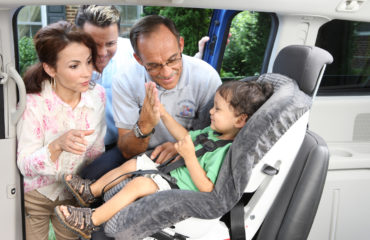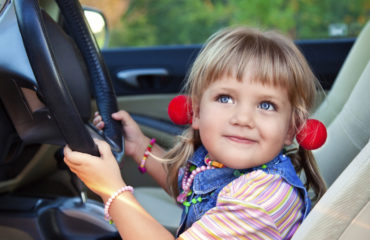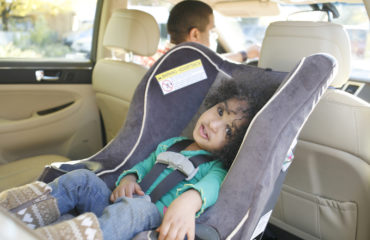Do you have children?
Do you have pets?
Do they travel with you in a car or truck?
If you answered yes to any of those questions, then this article is for you. With summer here, more children and pets are dying from heatstroke and these tragedies are 100% preventable. This article provides easy tips to ensure it doesn’t happen to your child or pet.
Heatstroke is Deadly
Heatstroke can happen anytime during the year, but it is more frequent during the summer. Since 1998 there have been at least 582 cases of children dying in vehicles because of heatstroke, with more than half under two years old. In 2012 there were 33 heatstroke deaths, with 21 so far in 2013. From 1998 to 2012, 29% of the heatstroke deaths happened because the child got into the car unattended to play.[1] According to NHTSA, heatstroke is the leading cause of non-crash vehicle fatalities for children 14 and under.[2] On average, a child dies in a car from heatstroke every 10 days.[3] There are no statistics on how many pets, typically dogs, die in a car from heatstroke, but there are news stories about it on a regular basis.
Sadly, it occurs so easily—a person stops to pick something up from the grocery store, goes inside the home preoccupied, or is just getting off the cell phone and the child or pet is left in the backseat. Ten minutes later, the person remembers but by then it is too late. On a hot day a child’s body absorbs heat up to 5 times faster than an adult’s. For dogs, their main method of cooling down is panting, which means breathing out the hot air and inhaling the cool. If the ambient air is hot, panting will have no benefit.
Consider how often you get into a car and find that you have to get back out, roll down the windows and wait for it to cool down, or grab the steering wheel only to quickly take your hands off of it because of the heat. This is a common experience for all of us. How does it happen? The objects inside a car, the steering wheel, the dashboard, even a child’s seat, receive heat from the sun’s shortwave radiation. Then the air around the particular item is heated. It doesn’t take long. On average, temperatures inside a car can rise almost 20 degrees in ten minutes and 30 degrees in 20 minutes.[4] Dark colored dashboards or seats get even hotter and leaving the window down “a crack” is of absolutely no benefit in any situation.
July 31st is National Heatstroke Prevention Day
It is time to get the message out to everyone, family, friends, co-workers, and community leaders, any way possible. On National Heatstroke Prevention Day it is planned that from 10 a.m. to 5 p.m. everyone, every hour, will send a tweet, or post a message on Facebook about stopping heatstroke. It is time to get involved. Click here to get to the website where you can download suggested tweets, Facebook messages, fact sheets, sample media templates such as letters to the editor, posters, PSA clips, and safety tips that you can share. In the meantime, there is more we can do individually.
Safety Recommendations for Parents[5]
- Never leave a child or pet in an unattended car, even with the windows down.
- Be sure that all occupants leave the vehicle when unloading. Don’t overlook sleeping babies or pets.
- Always lock your car. If a child is missing, check the car first, including the trunk. Teach your children that vehicles are never to be used as a play area.
- Keep a stuffed animal in the carseat and when the child is put in the seat place the animal in the front with the driver.
- Place your purse or briefcase in the back seat as a reminder that you have your child in the car.
- Make “look before you lock” a routine whenever you get out of the car.
Safety Recommendations for Bystanders
- If you see a child or pet alone in a hot vehicle, call the police.
- If they are in distress due to heat, get them out as quickly as possible. Cool the child or pet rapidly. Call 911 or your local emergency number immediately.
This past week was one of the hottest weeks this summer, and more hot days and weeks are coming. It is a critical time for parents, and non-parents alike to take action. If you see a child or a pet alone in a car—Act! And remember, the simplest act every parent with young children can do is: Look Before You Lock.
[1] Heatstroke Deaths of Children in Vehicles, Jan Null, CCM, Department of Geosciences, San Francisco State University.
[2] NHTSA Unveils Campaign to Prevent Child Heatstroke Deaths in Cars, NHTSA Press Release, April 3, 2012.
[3] Heatstroke Deaths of Children in Vehicles, Jan Null, CCM, Department of Geosciences, San Francisco State University.
[4] Heatstroke Deaths of Children in Vehicles, Jan Null, CCM, Department of Geosciences, San Francisco State University.
[5] Children-in-Car Fact Sheet, Jan Null, CCM, Department of Geosciences, San Francisco State University
Here is a video clip on Heatstroke-Called “One Decision”
Related articles
- Safety advocates, police warn: Leaving a child in unattended vehicle is potentially deadly (mlive.com)
- As Heat Wave Bakes Region, A Lesson On Kids and Pets in Cars (washington.cbslocal.com)







